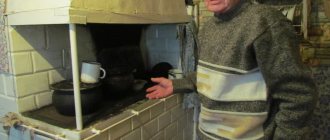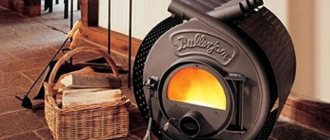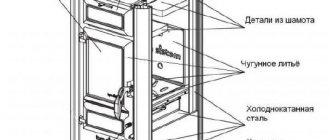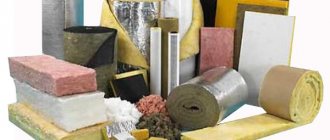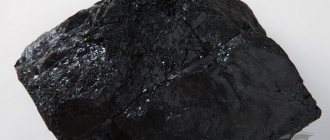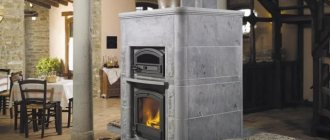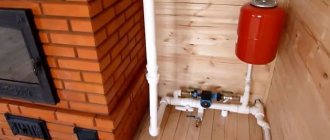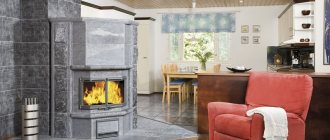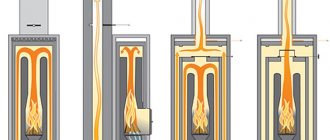The basis of any heater is the process of heat release when burning fuel or heating a conductor, in which all the conditions are created for the occurrence of electric current in it. On these foundations, many models of various stoves are built, the individualization of which is ensured by various features. But the most important thing that personalizes each model is the useful energy output, defined as efficiency. That is, all design improvements are aimed at increasing, at fixed costs, the share of energy converted into heat and used to heat the room.
You can work on the task in several directions.
- Increased combustion intensity. This will increase the energy released per unit time, but the efficiency often decreases as fuel consumption increases.
- Long burning technology. It is based on reducing intensity by limiting air access. As a result, the share of the released heat can be increased.
- Increased heat transfer efficiency. Many developments are based on the idea that the quality of room heating can be improved due to more efficient heat transfer. Convector ovens operate in this direction.
Modern metal heating device
The role of convection in heating a room
Heat in the house appears due to heated air. Even infrared emitters heat objects in the room, which, in turn, release energy to the surrounding air. But its thermal conductivity is too low, so heat transfer can only be accomplished through convection, that is, the movement of the air masses themselves.
The heated air rises upward under the influence of buoyant force. Cold air from neighboring areas enters the freed space. The air cools at the top and gradually falls down. This is how natural convection occurs, thanks to which uniform heating of the room space is possible.
Air movement in the room
In the process of transferring heat from the working fluid (let's call the heated elements of the furnace) to the coolant, whose role is played by air, convection will play a key role, ensuring effective heat exchange and increasing the overall share of useful energy. It’s worth mentioning right away that this is not the only way to transfer heat from the stove to the room. Do not forget about radiation and the penetration into the room of some combustion products that have a high temperature.
Good to know: How to build a muffle furnace for your home yourself
If there were no convection, then heat from the furnace would be transferred by conduction. The nearby layers of air would have a high temperature, but further the heating process would stop due to low thermal conductivity. Convection ensures the entry of a new batch of cold coolant and its removal after heating. This principle is used as the basis for the operation of convection ovens.
Water convector
Not so common among the consumer audience due to the complexity of installation and high cost. But if you have enough money for this type of heating, do not give it up in favor of others, since water heating convectors will serve as an excellent upgrade to your outdated heating system: the unit can be connected to supply pipes of any diameter and made of any material.
A water installation is not a dismountable device, it is a unit that functions as part of an autonomous heating system for an apartment or house.
Advantages of a water convector:
- compactness;
- light weight;
- heating rate;
- safety.
Flaws:
- high price;
- labor-intensive installation process.
Device
Regardless of the individual secrets of each design, the general basics of how stoves operate are the same. The main task of the developer is to ensure natural or forced air movement along the heated body using special convective channels.
How the system works
The movement of air through the channel is ensured by the Archimedes force, but in some models the complexity of the labyrinth does not allow the air to overcome excessive resistance. In this case, small fans are installed that provide injection of cold air and automatic displacement of heated air. Such an addition to the design must be preliminarily assessed in terms of energy costs so that it does not work with zero efficiency.
Warm floor
Home owners use heated water floors with their own hands, in two versions.
Warm floors evenly warm the room, increase the level of comfort and do not require additional energy costs, since the batteries and the floor circuit are powered from one boiler.
Self-installation of floors is quite accessible to owners who have carefully studied the principle of operation and the procedure for calculating heated floors. Before installation, you need to decide and purchase the necessary materials and components for the heated floor. During the installation of the circuit, strictly follow the rules and recommendations of specialists.
Ways to create a heated floor
In principle, a warm floor can be created in an apartment located in a multi-story building. But usually connection to the heating system is prohibited. If there is permission, then connection will require an examination of the influence of heated floors on the operation of the system. Typically, this design requires the installation of a separate pump and mixing unit. These additional elements will maintain system pressure at the outlet. In private houses, heated floors and a do-it-yourself heating system in a private house are inextricably linked.
The most popular methods of installing heated floors:
Pipes used for heated floors
To organize a heated floor, mainly three types of pipes are used. The best option is metal-plastic pipes, which are relatively cheap, easy to install and durable. Copper pipes are used, but they are very expensive, as well. They are inconvenient to work with because they are rigid, but they are not afraid of freezing and are easily repaired.
Kinds
If the operating principle of the stoves is the same, then the fuel used significantly affects the appearance and some technical nuances of the devices. Therefore, stoves are divided into certain categories, in particular, based on the type of fuel used.
Wood burning
A wood-burning stove is considered a classic in heating, because it can be made of brick according to all the traditions of folk craftsmen. In this case, when laying, convection channels immediately form near the firebox. They are vertical passages that open outwards from the bottom and top, for air supply and exhaust, respectively.
Firebox and convection channels
A metal wood stove combines compactness, efficiency, and advanced technology; it can be made of steel or cast iron. Typically, the firebox of such a stove is universal for using not only firewood, but also coal, pellets, wood waste, and paper. It is great for heating small spaces. The ability to adjust the supply of cold air allows you to operate the oven in several modes. Convector stoves for summer cottages are especially relevant, since sometimes it is necessary to quickly heat a small country house for the comfortable check-in of guests who have just arrived.
Metal version
Electrical
This device has earned the status of a stove due to the fact that it is capable of heating even just one room, but quickly and efficiently. Among consumers, the stove is better known as an electric convector.
Good to know: How to build a Russian housekeeper stove, Podgorodnikov model
The essence of the organization of its operation is that the air passes through a heating element made in the form of spirals. These spirals heat up when connected to an electrical circuit and heat the air. Models can be wall-mounted or portable. Wall convectors are fixed to the wall and resemble traditional heating radiators. A portable convector is good because it can heat the room in which you are directly located. Despite the absence of an open flame, oxygen is burned out when the heating elements operate, so room ventilation is a prerequisite for operating an electric convector.
Classic heater
Gas
The convection system and gas equipment were not spared. There are two types of devices here: a gas stove, which is a stationary structure, equipped with a chimney, and a gas convector fireplace, which can be installed in any room. Typically, fireplaces operate on bottled gas, but there is the possibility of supplying main fuel.
Gas heating device
Gas apparatus
In terms of the cost of equipment and its installation, gas convection heaters are in the middle between electric and water appliances. Their main problem is difficulties connecting to the gas mains or organizing fuel supply from propane cylinders. Otherwise, these are good devices for heating a private house or cottage, where people stay periodically and there is a risk of freezing the equipment or coolant in winter.
Essentially, the heater is a small convection boiler that burns natural and liquefied gas. Its heat exchanger, which is also a closed-type combustion chamber, also heats the air directly, and the heat exchange rate can be increased using a blower fan. Flue gases are emitted outside through the wall, and combustion air is taken from there through a coaxial pipe.
Main advantages
The use of technologies that make it possible to increase the efficiency of a heater without increasing the amount of fuel burned has opened up new opportunities for manufacturers of heating devices. A convection oven for home or industrial premises has some key advantages that allow it to attract the attention of consumers.
- Independence from electricity (with the exception of electric convectors) is in demand among residents of suburban areas that experience long-term power outages. Indeed, in the most difficult conditions, a metal stove can be heated with almost any type of fuel. The only recommendation is not to use plastic products or any paraffin-containing materials, as this can lead to premature cleaning of the chimney.
- Uniform heating not only affects the degree of comfort, but also reduces the time it takes to warm up the room. Today there is no more effective phenomenon than convection. Therefore, this type of heat transfer is used twice: when transferring energy to cold air and when distributing heated air throughout the room.
- Convection ovens are one of the few types of devices that allow you to effectively control and regulate the intensity of combustion.
- The possibility of using long-burning technology increases the interval between adding fuel portions to ten hours.
Good to know: How to build a muffle furnace for your home yourself
The list of positive qualities is not exhaustive, since the task was to identify precisely the distinctive features of the design.
Choosing your unit
What should we teach you about choice, dear reader, if you yourself know perfectly well the standard set of conditions?
Desires must correspond to possibilities - no one has yet canceled this rule.
Experts advise paying attention to the brand of the product and the obligatory visual “fitting” of the future purchase to suit your interior and the size of the room - you will not be happy with an inexpensive purchase if you notice that the floor heating convector (aka mobile) is too small and does not have the necessary power in order to heat the room efficiently. And here, don’t take it with you – it won’t help and won’t warm you up.
Power, design, installation method, energy consumption - everything should suit you in your newly acquired heat source. And then you will be happy with your purchase and feel comfortable in your home.
Tweet
Fence for a summer residence: which one to choose?
Custom-made furniture according to individual sizes
Roller blinds for plastic windows, photo in the interior
(Visited 377 times, 1 visits today)
